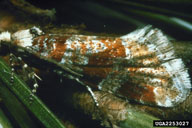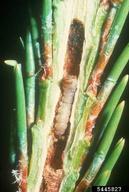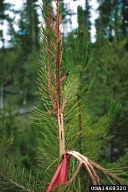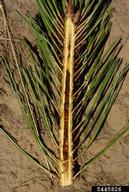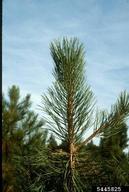Western pine shoot borer
Eucosma sonomana Kearfott (Lepidoptera: Tortricidae)
Orientation to pest
The western pine shoot borer, Eucosma sonomana Kearfott, is a significant pest of ponderosa (Pinus ponderosa Douglas ex C. Lawson) and lodgepole (Pinus contorta Douglas ex Louden) pines in many parts of the western North America, and is especially damaging to young, open-grown trees. Larvae bore in terminal shoots, feeding exclusively in the pith. As a result, they stunt the growth but rarely kill the terminals. Larvae leave shoots in late spring, drop to the ground, and pupate. Repeated attacks lead to shorter trees and may cause up to a 20% loss in volume growth over a rotation.
Hosts commonly attacked
In North America, this moth attacks ponderosa (P. ponderosa) and lodgepole (P. contorta) pines.
Distribution
In North America, this moth occurs is recorded from Arizona, New Mexico, Wyoming, Colorado, Utah, South Dakota, Montana, Idaho, California, Oregon, Washington, and British Columbia (see map in Sartwell et al., 1980).
Images of western pine shoot borer
| Figure 1. Adult of western pine shoot borer, Eucosma sonomana | Figure 2. Larva of western pine shoot borer in leader |
| Figure 3. Tunnels of western pine shoot borer in lodgepole pine | Figure 4. Terminal of pine damaged by western pine shoot moth | |
Important biological control agents related to this pest species
No information was available on natural enemies of this species.
Articles
- Stevens, R. E. and D. T. Jennings. 1977. Western pine shoot borer: A threat to intensive management of ponderosa pine in the Rocky Mountain area and southwest. USDA Forest Service, Rocky Mountain Forest and Range Experiment Station, Fort Collins, Colorado, General Technical Report RM-45, 8 pp.
- Sartwell, C. G. E. Daterman, T. W. Koerber, R. E. Stevens, and L. L. Sower. 1980. Distribution and hosts of Eucosoma sonomana in the western United States as determined by trapping with synthetic sex attractants. Annals of Entomological Society of America 73: 254-256.
